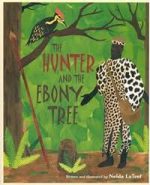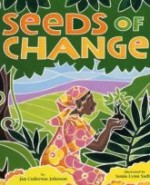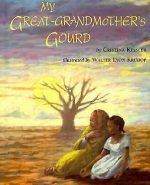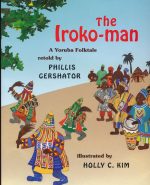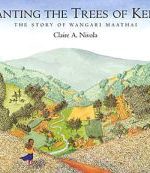- Kenya
Echewa, T. Obinkaram. Magic Tree : A Folktale from Nigeria. New York : William Morrow, 1999.
Summary: Although Mbi, an orphan boy, is constantly asked to “do this” and “do that” by his many unkind relatives until a special tree grows, just for him.
Foggo, Cheryl. Dear Baobab. Toronto : Second Story Press, 2011.
Summary: An African boy struggles with homesickness as he adjusts to life in North America.
Gershator, Phillis. Iroko – man : A Yoruba Folktale. New York : Watts / Orchard, 1994.
Summary: An adaptation of a Yoruba tale. When the terrifying Iroko-man tries to take a woodcarver’s first-born child as partial payment for bringing fertility to his village, the father must find a clever solution.
Hooks, Gwendolyn. Planting peace : the story of Wangari Maathai.
Summary: “This picture book tells the inspiring story of Wangari Maathai, women’s rights activist and one of the first environmental warriors. Wangari began the Green Belt Movement in Kenya in the 1960s, which focused on planting trees, environmental conservation, and women’s rights.”
Johnson, Jen Cullerton. Seeds of Change : Planting a Path to Peace. New York, NY : Lee & Low Books, 2010.
Summary: “A picture book biography of scientist Wangari Maathai, the first African woman–and first environmentalist–to win a Nobel Peace Prize (in 2004), for her work planting trees in … Kenya. “.
Joo, Mi-hwa, author. Thank you, baobab tree! This English edition published by Big & Small in 2016.
Summary: “There are eight species of baobab tree and all are found in Madagascar which is called the ‘home of the baobab’. This story is about a family who get their daily needs from baobab trees”–Back cover.
Kessler, Christina. My Great – grandmother’s Gourd. New York : Orchard, 2000.
Summary: Relays a true story about generations of a family coming together in modern-day Africa.
LaTeef, Nelda. Hunter and the Ebony Tree. North Kingstown, RI : Moon Mountain, 2002.
Summary: |A Zarma courtship folktale collected by the author in the Republic of Niger. A father imposes an “impossible” archery content as a test to find a proper husband for his beautiful daughter. The hunter calls upon his friends the woodpecker, the spider and.
Maathai, Wangari. The Green Belt Movement : Sharing the Approach and the Experience. New York : Lantern / Booklight, 1985 rev. 2008.
Summary: “First published in 1985. The author relates the origins and philosophy of the Green Belt Movement in Kenya which has planted millions of trees throughout East Africa and discusses how it operates, the challenges they face, and the objectives for the future of their nation.”.
Maathai, Wangari. Unbowed : a memoir. New York : Knopf, 2006.
Summary: Maathai, the winner of the 2004 Nobel Peace Prize and a single mother of three, recounts her life as a political activist, feminist, and environmentalist in Kenya.
McQuerry, Maureen, 2022. Big Ideas for Little Environmentalists: Restoration with Wangari Maathai.
Naidoo, Beverley. Aesop’s Fables. London : Frances Lincoln, 2011.
Summary: Here are 16 of Aesop’s wise, witty and timeless fables, portrayed for the first time in an African setting.
Napoli, Donna Jo. Mama Miti : Wangari Maathai and the trees of Kenya. New York : Simon & Schuster Books for Young Reade, 2010.
Summary: Wangari Maathai, known as Mama Miti, mother of trees, shares her wisdom with other women by advising them to plant trees native to Kenya to solve their many problems.
Nivola, Claire A. Planting the Trees of Kenya : The Story of Wangari Maathai. New York : Farrar, Straus, and Giroux, 2008.
Summary: Wangari Maathai, winner of the 2004 Nobel Peace Prize and founder of the Green Belt Movement, grew up in the highlands of Kenya, where fig trees cloaked the hills, fish filled the streams, and the people tended their bountiful gardens. But over many years, as more and more land was cleared, Kenya was transformed.
Onyefulu, Ifeoma. Grandfather’s Work : A Traditional Healer in Nigeria. Brookfield, Conn : Millbrook Press, 1998.
Summary: A child describes the work of his grandfather, a traditional healer in a Nigerian village, comparing it to the work of other family members. Includes information about plants used in healing.
Prévot, Franck, 1968- author. Wangari Maathai : the woman who planted millions of trees. 2015 First US edition.
Summary: Tells the story of environmentalist and Nobel Peace Prize winner Wangari Maathai.
Stevenson, Tambra Raye. Little Wanda finds a cure for Nana.
Summary: With her magic apron, she travels to Africa to meet the female farmer, Big WANDA who shares the health and beauty of African foods. The bilingual book series is in English and Hausa.
Stock, Catherine. Gugu’s House. New York : Clarion, 2001.
Summary: Kukamba loves helping her grandmother decorate her earthen home in a Zimbabwe village, but when the annual rains partially destroy all her art work, Kukamba learns to see the goodness of the rains.
Swanson, Jennifer, author. Environmental activist Wangari Maathai.
Summary: : “[Discusses the life and work of African Wangari Maathai, who] started the Green Belt Movement, which educated women in rural villages and paid them for every tree they planted. The program helped plant millions of trees and brought money to the villages. For her environmental and human rights work, Maathai became the first African woman to receive the Nobel Peace Prize.”–Publisher.
Williamson, Emily and Students and Teachers of the Hassaniyya Quranic School in Cape Coast, Ghana. Gizo – Gizo : A Tale from the Zongo Lagoon.
Summary:
Winter, Jeanette. Wangari’s Trees of Peace : a true story from Africa. Orlando, FL : Harcourt Children’s Books, 2008.
Summary: This true story of Wangari Maathai, environmentalist and winner of the Nobel Peace Prize, is a shining example of how one woman’s passion, vision, and determination inspired great change.

